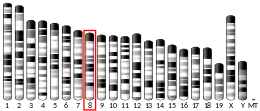Iroquois-class homeodomain protein IRX-3, also known as Iroquois homeobox protein 3, is a protein that in humans is encoded by the IRX3 gene.[5]
Discovery and name
The Iroquois family of genes was discovered in Drosophila during a mutagenesis experiment designed to identify genes that affected the development of external sensory organs. When genes of this family were knocked out, the Drosophila flies expressed a unique patterning of bristles reminiscent of Iroquois American Indians, they were subsequently named after them.[6] The molecular characteristics of these genes allowed the identification of homologs in C. elegans and several other vertebrates.[7]
Function
IRX3 is a member of the Iroquois homeobox gene family and plays a role in an early step of neural development.[8] Members of this family appear to play multiple roles during pattern formation of vertebrate embryos.[5][9] Specifically, IRX3 contributes to pattern formation in the spinal cord where it translates a morphogen gradient into transcriptional events, and is directly regulated by NKX2-2.[10] The Irx3 gene controls the subdivision of the neural territory by working together with various other homeodomain factors, all of these factors are expressed in partially overlapping domains along the dorsoventral axis in response to Sonic hedgehog molecules emanating from the floor plate. The combination of these signals defines five regions, each of which will give rise to five types of neurons (V0, V1, V2, MN, and V3). For example, the region that generates V2 neurons expresses both Irx3 and Nkx6.1, while that which forms MN neurons expresses Nkx6.1 alone. Irx3 overexpression in the MN domain transforms MN into V2 neurons.[11]
Clinical significance
Association with obesity
Obesity-associated noncoding sequences within FTO interact with the promoter of IRX3 and FTO in human, mouse, and zebrafish. Obesity-associated single nucleotide polymorphisms are related to the expression of IRX3 (not FTO) in the human brain. A direct connection between the expression of IRX3 and body mass and composition was shown through the decrease in body weight of 25-30% in IRX3-deficient mice. This suggests that IRX3 influences obesity.[12] Manipulation of IRX3 and IRX5 pathways has also been shown to decrease obesity markers in human cell cultures.[13] Genetic variants of FTO and IRX3 genes are in high linkage disequilibrium and are associated with obesity risk.[14]
References
- 1 2 3 GRCh38: Ensembl release 89: ENSG00000177508 - Ensembl, May 2017
- 1 2 3 GRCm38: Ensembl release 89: ENSMUSG00000031734 - Ensembl, May 2017
- ↑ "Human PubMed Reference:". National Center for Biotechnology Information, U.S. National Library of Medicine.
- ↑ "Mouse PubMed Reference:". National Center for Biotechnology Information, U.S. National Library of Medicine.
- 1 2 "Entrez Gene: iroquois homeobox 3".
- ↑ Chaudière, C Dambly; Leyns, L (1992). "The determination of sense organs in Drosophila: a search for interacting genes". The International Journal of Developmental Biology. 36 (85–91).
- ↑ Cavodeassi, Florencia; Modolell, Juan; Gomez-Skarmeta, Jose Luis (2001). "The Iroquois family of genes: from body building to neural patterning". Development. 128 (2847–2855): 2847–2855. doi:10.1242/dev.128.15.2847. hdl:10261/198505. PMID 11532909.
- ↑ Bellefroid EJ, Kobbe A, Gruss P, Pieler T, Gurdon JB, Papalopulu N (Jan 1998). "Xiro3 encodes a Xenopus homolog of the Drosophila Iroquois genes and functions in neural specification". The EMBO Journal. 17 (1): 191–203. doi:10.1093/emboj/17.1.191. PMC 1170370. PMID 9427753.
- ↑ Lewis MT, Ross S, Strickland PA, Snyder CJ, Daniel CW (Jun 1999). "Regulated expression patterns of IRX-2, an Iroquois-class homeobox gene, in the human breast". Cell and Tissue Research. 296 (3): 549–54. doi:10.1007/s004410051316. PMID 10370142. S2CID 37046813.
- ↑ Lovrics A, Gao Y, Juhász B, Bock I, Byrne HM, Dinnyés A, Kovács KA (November 2014). "Boolean modelling reveals new regulatory connections between transcription factors orchestrating the development of the ventral spinal cord". PLOS ONE. 9 (11): e111430. Bibcode:2014PLoSO...9k1430L. doi:10.1371/journal.pone.0111430. PMC 4232242. PMID 25398016.
- ↑ Cavodeassi, Florencia; Modolell, Juan; Gomez-Skarmeta, Jose Luis (2001). "The Iroquois family of genes: from body building to neural patterning". Development. 128 (2847–2855): 2847–2855. doi:10.1242/dev.128.15.2847. hdl:10261/198505. PMID 11532909.
- ↑ Smemo S, Tena JJ, Kim KH, Gamazon ER, Sakabe NJ, Gómez-Marín C, et al. (Mar 2014). "Obesity-associated variants within FTO form long-range functional connections with IRX3". Nature. 507 (7492): 371–5. Bibcode:2014Natur.507..371S. doi:10.1038/nature13138. PMC 4113484. PMID 24646999.
- ↑ Claussnitzer M, Dankel S, Kim KH, Quon G, Meuleman W, Haugen C, et al. (Aug 2015). "FTO Obesity Variant Circuitry and Adipocyte Browning in Humans". New England Journal of Medicine. 373 (10): 895–907. doi:10.1056/NEJMoa1502214. PMC 4959911. PMID 26287746.
- Jessica Bartlett (20 August 2015). "MIT, Harvard find 'master switch' behind obesity". Boston Business Journal.
- ↑ Srivastava A, Mittal B, Prakash J, Srivastava P, Srivastava N, Srivastava N (2015). "Association of FTO and IRX3 genetic variants to obesity risk in north India". Annals of Human Biology. 43 (5): 1–6. doi:10.3109/03014460.2015.1103902. PMID 26440677. S2CID 19868664.
Further reading
- Trynka G, Zhernakova A, Romanos J, Franke L, Hunt KA, Turner G, et al. (Aug 2009). "Coeliac disease-associated risk variants in TNFAIP3 and REL implicate altered NF-kappaB signalling". Gut. 58 (8): 1078–83. doi:10.1136/gut.2008.169052. PMID 19240061. S2CID 17111427.
- Ragvin A, Moro E, Fredman D, Navratilova P, Drivenes Ø, Engström PG, et al. (Jan 2010). "Long-range gene regulation links genomic type 2 diabetes and obesity risk regions to HHEX, SOX4, and IRX3". Proceedings of the National Academy of Sciences of the United States of America. 107 (2): 775–80. Bibcode:2010PNAS..107..775R. doi:10.1073/pnas.0911591107. PMC 2818943. PMID 20080751.
This article incorporates text from the United States National Library of Medicine, which is in the public domain.



